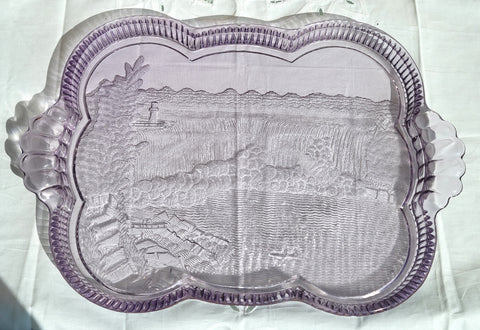Purple glass, which is often referred to as ‘Desert Glass’ or Sun Colored Glass, has been a popular collectors’ item for decades. Originally, this glass is clear, or colorless, and it is the only glass known which, when exposed to the ultraviolet rays coming from the sun, changes from clear to pink, and then purple amethyst color. Thus, empty glass containers tossed carelessly aside in the desert in years past, or the backyard or town dump, in time turned into the highly desired and collectable purple desert glass of today. The time it takes to turn colors varies, but is usually measured in years rather than in months. Glass turns slowly, if at all, if not exposed directly to the sun’s rays. It is the ultraviolet radiation that does the trick!
The introduction of high volume, mass production of glass bottles, containers and other glassware items by machinery began in the mid 1800’s. Of course, many pieces of glassware were hand blown then, as they are now, and using similar techniques. The most inexpensive glass fabricated often made use of rather poorly refined glass sand containing iron. This produced a naturally green or aqua colored glass, often used for inexpensive or economical, one-time-use bottles and glassware, particularly where color was of little importance. The early green Coca Cola bottles are an excellent example of this kind of glass.
In order to produce a ‘crystal clear’ glass, an essential element, manganese, was added along with the other basic ingredients that make up glass sand to counter the green effect of the iron. This produced a crystal clear glass until, of course, the glass was exposed to direct sunlight and in turn began to change! Glass manufacturers were well aware of the effect of this combination of iron and manganese together and hence, this type of glass was seldom used where the effect of the color change might be undesirable, such as window pane glass or in high quality decorative crystal.
The practice of mixing manganese with lower quality, iron-rich glass sands in manufacturing disposable glassware continued from the mid-1800’s until about 1914 when, with the advent of World War I, the supply of manganese from Germany was cut off. However, new methods were developed to produce ‘crystal clear’ glass, and the manganese was no longer needed to counteract the effect of iron in the sands used for these mass produced glass items.
The intensity of the color change of the individual pieces is determined by the amount of manganese used in that particular batch of glass. As a result we find some pieces light in color, looking more pink than purple, and some darker, with a rich, intense amethyst color.

Only select pieces of glass made during the years between about 1848 and 1914 will turn a deep purple color, and only after a prolonged exposure to the sun’s ultraviolet rays. Because of the age of the glass, the small subset of glass products which used this production technique, and the need for extended exposure to the sun’s light, Purple Sun Colored Antique Glass is a rare and collectible artifact, and fascinating piece of industrial history. Today the supply is extremely limited. Examples that are in good condition are rare. As with all such scarce collectibles, the values continue to appreciate.
Leave a comment